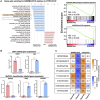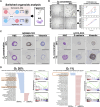Hypoxia at 3D organoid establishment selects essential subclones within heterogenous pancreatic cancer
- PMID: 38374892
- PMCID: PMC10875002
- DOI: 10.3389/fcell.2024.1327772
Hypoxia at 3D organoid establishment selects essential subclones within heterogenous pancreatic cancer
Abstract
Pancreatic ductal adenocarcinoma (PDAC) is especially hypoxic and composed of heterogeneous cell populations containing hypoxia-adapted cells. Hypoxia as a microenvironment of PDAC is known to cause epithelial-mesenchymal transition (EMT) and resistance to therapy. Therefore, cells adapted to hypoxia possess malignant traits that should be targeted for therapy. However, current 3D organoid culture systems are usually cultured under normoxia, losing hypoxia-adapted cells due to selectivity bias at the time of organoid establishment. To overcome any potential selection bias, we focused on oxygen concentration during the establishment of 3D organoids. We subjected identical PDAC surgical samples to normoxia (O2 20%) or hypoxia (O2 1%), yielding glandular and solid organoid morphology, respectively. Pancreatic cancer organoids established under hypoxia displayed higher expression of EMT-related proteins, a Moffitt basal-like subtype transcriptome, and higher 5-FU resistance in contrast to organoids established under normoxia. We suggest that hypoxia during organoid establishment efficiently selects for hypoxia-adapted cells possibly responsible for PDAC malignant traits, facilitating a fundamental source for elucidating and developing new treatment strategies against PDAC.
Keywords: 3D organoid; hypoxia; pancreatic cancer; selection bias; tumor heterogeneity.
Copyright © 2024 Kumano, Nakahashi, Louphrasitthiphol, Kuroda, Miyazaki, Shimomura, Hashimoto, Akashi, Mathis, Kim, Owada, Goding and Oda.
Conflict of interest statement
The authors declare that the research was conducted in the absence of any commercial or financial relationships that could be construed as a potential conflict of interest.
Figures




References
-
- abou Khouzam R., Rao S. P., Venkatesh G. H., Zeinelabdin N. A., Buart S., Meylan M., et al. (2021). An eight-gene hypoxia signature predicts survival in pancreatic cancer and is associated with an immunosuppressed tumor microenvironment. Front. Immunol. 12, 680435. 10.3389/fimmu.2021.680435 - DOI - PMC - PubMed
LinkOut - more resources
Full Text Sources
Molecular Biology Databases

